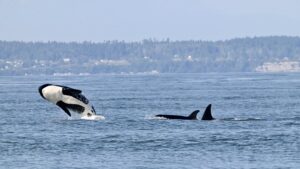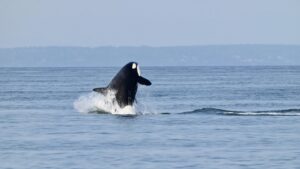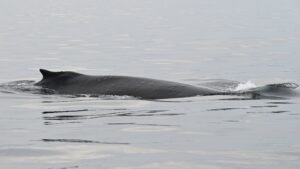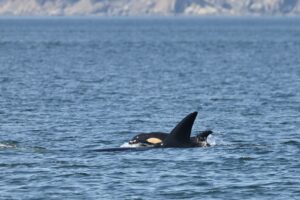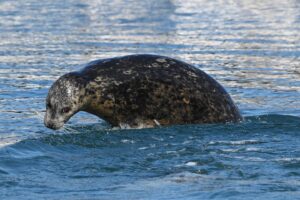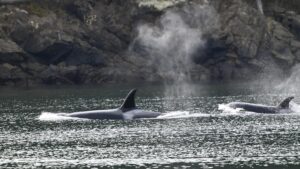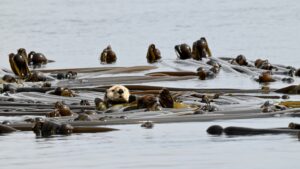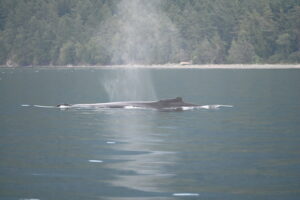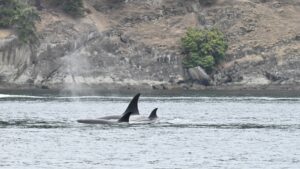We had another fantastic round of tours while out on the water this week, not letting some foggy mornings and/or smoke-hazy afternoons keep us from enjoying the beauty and the bounty of wildlife that the Salish Sea has to offer. Bigg’s killer whales were meandering around from the far reaches of southern Puget Sound near Olympia, all the way up to the Campbell River in British Columbia. We’ve been happy to see several family groups popping in and out of the Gulf Islands and the San Juan Islands area–part of our tour range–as well.
Bigg’s killer whale families that were encountered on our tours this week were: the T46s (4), T46Bs (8), T49As (5), T63 & T65 (2), T65A5, T65Bs (4), T75Bs (5), T124Ds (4), and the T137s (4). We were wondering when the T137s might show back up, and somehow, even with T137A Jack’s massive dorsal fin, they managed to sneak into the eastern reaches of the Strait of Juan de Fuca before they were detected! In total, across all of our tours this past week, we encountered 37 individuals from this population.
A “wee” bit of news! On Friday August 22nd the T75Bs were first sighted along the west side of San Juan Island after being outside of the Salish Sea for some time (potentially since the end of July), and there was a new, itty bitty, orange-hued calf tucked in with this group! Center for Whale Research was on the water and broke the news, and of course, the entire whale watching community was instantly over the moon. After a few days of subsequent encounters, it was determined that this little one was the fifth recorded offspring for T75B, making their designation T75B5. This conclusion was drawn based on the calf sticking very tight to T75B, often seen in the echelon position, which is where the calf would receive the benefit of swimming along in their mother’s slip stream. Researchers definitely wanted to observe the calf and the group through several encounters in case T75B2 (a female born in 2015) may have been the mother. Typically, ten years old would be young for a first time mother, but T75B2 already had a calf back in 2023 that did not survive. The lack of survival of T75B2A could have been due to her mother’s young age; we are rooting for her to have another, regardless! Several of our tours this past week were able to get out and see the newest Bigg’s, and later on in the week, a naturalist with another whale watch company got the coveted photo of this calf’s belly to reveal the sex–a female! Take a look at one of the photos below for orca cuteness overload!
Humpbacks were also encountered throughout tours this past week including individuals that were identified as BCZ0345 “Victory,” BCX 1658 “Bullet,” BCX1920 “Octo,” and BCX1852 “Raza.” Two of these humpbacks pushed through the islands as they continued north toward the Strait of Georgia, and then Octo was re-sighted up off of Galiano Island in BC several days after being out in the Strait of Juan de Fuca! Humpbacks can really cover some distance in the pursuit of food. Just like us, they will often switch up their “restaurant of choice,” and when they make that decision their trek could bring them back through the islands where we often intercept them for a short time.
Minke whales were also seen on a couple of our tours around Salmon Bank and out around Dallas Bank, near Protection Island, on one of our jaunts out that way. These animals are still pursuing bait fish, feeding as much as they can before they take off for their fall/winter migration back to warmer waters.
A few other notable sightings: a sea otter near Cattle Pass enjoying a “spa day,” and a pair of very active harbor seals that were playing with each other in the boat slip just next to us as we were departing for one of our morning tours. In all, it was a great week, and as always, we are looking forward to seeing what the next week of wildlife sightings is going to bring us.
